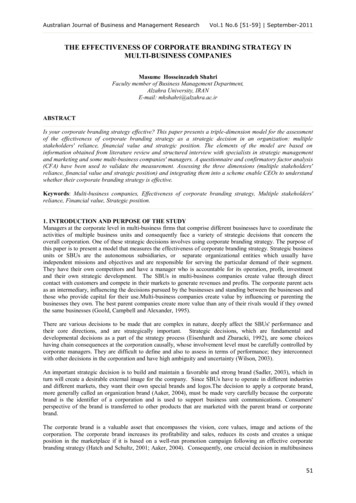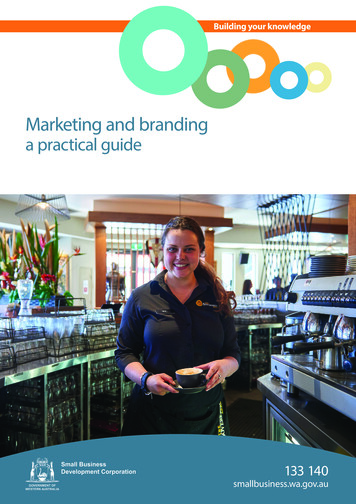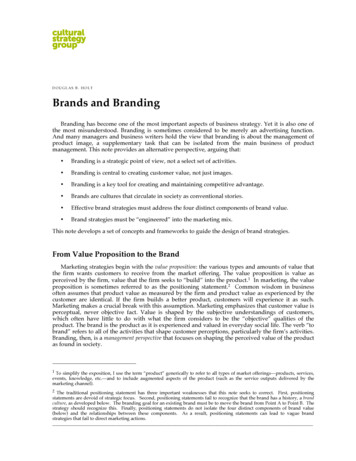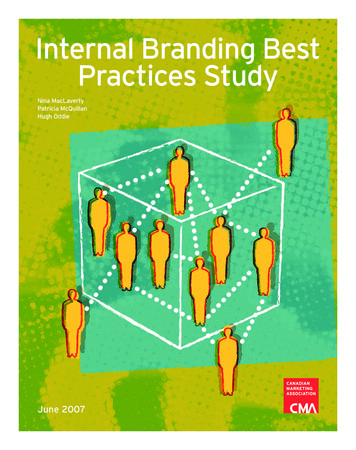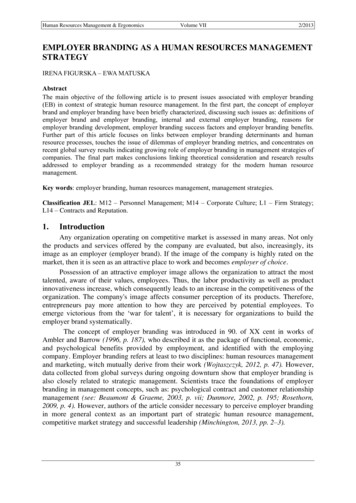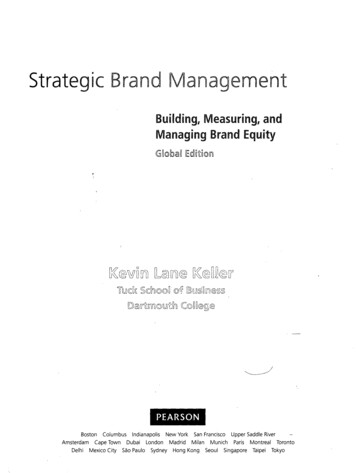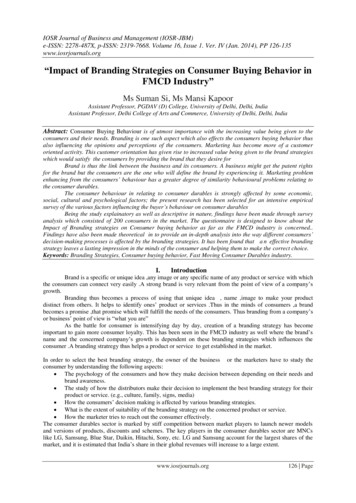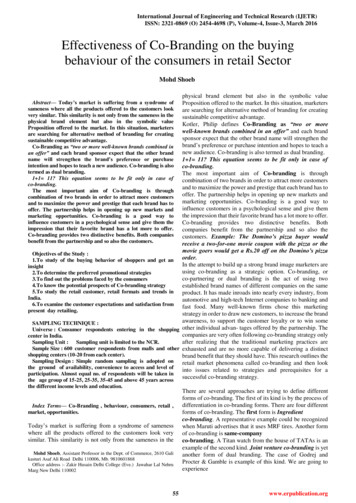
Transcription
International Journal of Engineering and Technical Research (IJETR)ISSN: 2321-0869 (O) 2454-4698 (P), Volume-4, Issue-3, March 2016Effectiveness of Co-Branding on the buyingbehaviour of the consumers in retail SectorMohd Shoeb physical brand element but also in the symbolic valueProposition offered to the market. In this situation, marketersare searching for alternative method of branding for creatingsustainable competitive advantage.Kotler, Philip defines Co-Branding as “two or morewell-known brands combined in an offer” and each brandsponsor expect that the other brand name will strengthen thebrand‟s preference or purchase intention and hopes to teach anew audience. Co-branding is also termed as dual branding.1 1 11? This equation seems to be fit only in case ofco-branding.The most important aim of Co-branding is throughcombination of two brands in order to attract more customersand to maximize the power and prestige that each brand has tooffer. The partnership helps in opening up new markets andmarketing opportunities. Co-branding is a good way toinfluence customers in a psychological sense and give themthe impression that their favorite brand has a lot more to offer.Co-branding provides two distinctive benefits. Bothcompanies benefit from the partnership and so also thecustomers. Example: The Domino’s pizza buyer wouldreceive a two-for-one movie coupon with the pizza or themovie goers would get a Rs.20 off on the Domino’s pizzaObjectives of the Study :order.1. To study of the buying behavior of shoppers and get anIn the attempt to build up a strong brand image marketers areinsightusing co-branding as a strategic option. Co-branding, or2. To determine the preferred promotional strategiesco-partnering or dual branding is the act of using two3. To find out the problems faced by the consumers4. To know the potential prospects of Co-branding strategyestablished brand names of different companies on the same5. To study the retail customer, retail formats and trends inproduct. It has made inroads into nearly every industry, fromIndia.automotive and high-tech Internet companies to banking and6. To examine the customer expectations and satisfaction fromfast food. Many well-known firms chose this marketingpresent day retailing.strategy in order to draw new customers, to increase the brandawareness, to support the customer loyalty or to win someSAMPLING TECHNIQUE :Universe : Consumer respondents entering in the shopping other individual advan- tages offered by the partnership. Thecompanies are very often following co-branding strategy onlycenter in India.after realizing that the traditional marketing practices areSampling Unit : Sampling unit is limited to the NCR.Sample Size : 600 customer respondents from malls and other exhausted and are no more capable of delivering a distinctshopping centers (10-20 from each center).brand benefit that they should have. This research outlines theSampling Design : Simple random sampling is adopted onretail market phenomena called co-branding and then lookthe ground of availability, convenience to access and level ofinto issues related to strategies and prerequisites for aparticipation. Almost equal no. of respondents will be taken insuccessful co-branding strategy.the age group of 15-25, 25-35, 35-45 and above 45 years acrossAbstract— Today‟s market is suffering from a syndrome ofsameness where all the products offered to the customers lookvery similar. This similarity is not only from the sameness in thephysical brand element but also in the symbolic valueProposition offered to the market. In this situation, marketersare searching for alternative method of branding for creatingsustainable competitive advantage.Co-Branding as “two or more well-known brands combined inan offer” and each brand sponsor expect that the other brandname will strengthen the brand‟s preference or purchaseintention and hopes to teach a new audience. Co-branding is alsotermed as dual branding.1 1 11? This equation seems to be fit only in case ofco-branding.The most important aim of Co-branding is throughcombination of two brands in order to attract more customersand to maximize the power and prestige that each brand has tooffer. The partnership helps in opening up new markets andmarketing opportunities. Co-branding is a good way toinfluence customers in a psychological sense and give them theimpression that their favorite brand has a lot more to offer.Co-branding provides two distinctive benefits. Both companiesbenefit from the partnership and so also the customers.the different income levels and education.Index Terms— Co-Branding , behaviour, consumers, retail ,market, opportunities.Today‟s market is suffering from a syndrome of samenesswhere all the products offered to the customers look verysimilar. This similarity is not only from the sameness in theMohd Shoeb, Assistant Professor in the Dept. of Commerce, 2610 Galikasturi Asaf Ali Road Delhi 110006, Mb. 9810601868Office address :- Zakir Husain Delhi College (Eve.) Jawahar Lal NehruMarg New Delhi 11000255There are several approaches are trying to define differentforms of co-branding. The first of its kind is by the process ofdifferentiation in co-branding forms. There are four differentforms of co-branding. The first form is Ingredientco-branding. A representative example could be recognizedwhen Maruti advertises that it uses MRF tires. Another formof co-branding is same-companyco-branding. A Titan watch from the house of TATAs is anexample of the second kind. Joint venture co-branding is yetanother form of dual branding. The case of Godrej andProcter & Gamble is example of this kind. We are going toexperiencewww.erpublication.org
Effectiveness of Co-Branding on the buying behaviour of the consumers in retail Sector The Indian retail revolution has garnered suchunprecedented attention that it now seems to be hottest sectorto be present in. „Retail management„ and „last-milemanagement‟, be it for the manufacturers and serviceproviders or the retail chains alike, has the potential to emergeas a charming lady luck. If economy continues a growth of7-8% of the GDP annually, estimated by 2010, retailers willcomprise of 300bn industry. Retailing is the last stage ofdistribution process. It is one of the fundamental blocks of theIndian economy. Indian retail market has undergone animmense transformation in the post liberalization period & iswitnessing a tremendous growth. Indian retail sector isgrowing at the rate of 30% per annum and provides highestemployment after agriculture in India. Traditional markets are making way for new formatsuch as departmental stores, shopping malls, hypermarkets,super markets and specialty stores. Western-style malls havebegun appearing in the metros and other cities alike,introducing the Indian consumers to an unparalleledshopping experiences. To woo the customers to the stores,retailers are providing a wide range of various Products, quality and value for money with thedifferent exciting and tempting Offers apart from creating a memorable shoppingexperience.Consumers Buying Behavior :The consumer behavior is the root of all marketing strategiesand is must to optimize sales, profit and ensure consumersatisfaction. All advertisement, sales promotion, salesschemes, prize schemes are based on consumer research.Normally in consumer behavior, one studies the behavior ofconsumers for consumption of goods but in this study, thebehavior of buyers is also included. He may be user i.e.ultimate consumer or buying for someone else. The behaviorof consumer is dependent on a number of factors, which maybe economic, or non -economic factors. Economic factors aresuch as income, price, competition etc. and non-economicfactors are like social, cultural, psychological andgeographical. Consumers tend to assign various descriptivepersonality or characteristics to different brands in a widevariety of product categories. This is the one of most effectiveuse of the concept of brand personality in marketingapplications. Consumers have consistent patterns that guidetheir decision to all brands or consumption situations.more number of joint ventures branding in near future.Finally, there is multiple sponsor form of co-brands as in thecase of HCL computers with hardware alliance of HP,processor alliance of Intel and software alliance of Microsoft.Examples of Co-branding :WIPRO (Indian Co.) and ACER (Taiwan Co.) has joinhands in offering laptop in the Indian market. BharatPetroleum Ltd. Has formed an alliance with the Bank ofBaroda to launch the co-branded debit card namely BharatBOB card. Similarly, Andhra Bank and Hindustan Petroleumalso launched their co-branded card. Some other examples arefollowing : IRCTC and SBI cards has launched its first evenfrequent program and co-branded credit card – the SBIRailway card. Nokia (mobile phone manufacturer) and BhartiAirtel (cellular service provider) has joined the hands. Reliance CDMA service provider is giving the LG,Samsung and Nokia mobile phones with the CDMAconnection. Similarly, The Tata Indicom is doing. Recently, the two automobile companies TATAand FIATE have joined the hands in this sector to enhancetheir business in India. Now the TATA and FIATECompanies are selling their cars at the TATA‟s showroomsand they will provide after sale services at the TATA‟s servicecenters. It is a better example of Co-Branding in India. HDFC bank and Idea cellular launched twoco-branded cards providing multiple benefits to the customersof both. LG Electronics India and SBI cards announced thelaunch of the LG-SBI card. This is the country‟s firstco-branded for the consumer appliances industry and can beused at more than 2 lakh outlets in India. Maruti-Suzuki is providing insurance services to itscustomers with the alliance of ICICI Lombard co. andNational Insurance Company Ltd. Andhra Bank and ICFAI University are using thestrategy of co-branding. Maximum of the real estate developers areproviding home loan facility to the customer at the time ofbooking of property with the alliances of the nationalize andprivate sector banks as PNB, SBI, BOB, ICICI, HDFC banksetc. Retail Sector in India : The retail sector has become one of themost dynamic growing sectors in recent times. Retailing hasalways been an integral part of economic development.Nations with strong retail activity have enjoyed a greatereconomic and social progress. Retailing in India is graduallyinching its way towards becoming the next boom industry. ATKearny, the well known international consultancy, recentlyidentified India as the “second most attractive destination”globally from among thirty emergent markets. In India theunorganized retail sector comprises of 95%, while that oforganized sectors just of 5% that is only in major metropolitanand urban areas. Indian retailing traditionally was dominatedby a small family run “kirana” store. Retailing in India is thesecond largest untapped market after China. Despite the hugesize of the industry only 8% of the country‟s population isengaged in retailing while that in USA, it is 20%.Review of Literature :Despite the growing use of co-branding in practice, littleempirical research has been conducted on the topic. Most ofthe literature on co-branding simply describes the strategy ordiscusses the advantages and disadvantages of co-brandingarrangements. There are however some empirical studiesdealing with this topic.In the first study by Simon and Ruth (1998) consumerattitudes towards brand alliances are examined. The focus inthis work is on spillover effects of brand alliance evaluationson the later evaluation of partners and on the role of brandfamiliarity in these relationships. The result of this study isthat consumers attitudes toward a particular brand allianceinfluenced their subsequent attitudes toward the individualbrands that comprise that alliance.The second study by Park et al. (1996) deals with aComposite Brand Extension (CBE), combination of56www.erpublication.org
International Journal of Engineering and Technical Research (IJETR)ISSN: 2321-0869 (O) 2454-4698 (P), Volume-4, Issue-3, March 2016existing brand names, analogous to co-brand. It examineshow consumers form the concept of the CBE based on theirconcept of their constituent brands, the roles of eachconstituent brand in forming this conceptand the effectiveness of the CBE strategy. According to thestudy a composite brand name can favorably influencesubjects perception of the CBE and those complementaritiesbetween the primary and secondary constituent brands is amore important factor in the success of the CBE strategy thana positive evaluation of the secondary brand.Vikas Saraaf, in his research “Branding- Hub of the corporatewheel” studied the necessity of branding. Study reveals thechanging basis for brand management and it is also reveal thathow to create brand image and brand loyalty. The authorconcluded that branding is everything and brands are notsimply products or services.Tapan K Panda, in his paper “Strategic Advantage throughSuccessful Co-Branding” Concluded that Co-branding is adynamic branding strategy and its significance is growingespecially with the increasing importance of Internet as amedium. Although the benefits of co-branding are immenseespecially in a complex market like that of India but there arealso some risks, which are inherent in the concept.Mohit Taneja, Jayanti Kalyani, in his paper “Co-branding:Beyond Brands” revealed that In case of the retail sectorwhich will be on a boom in the coming years we may see largeretail chains becoming increasingly assertive in requiringspecial co – branded packs of leading brand name productsrather than pursuing the supermarkets tactic of developinglook-alikes own label products which mimic the get up of thebrand leader.Several scholars have also argued that the prior attitude playsan important role in the evaluation process of co-branding(Boo and Mattila, 2002; Lafferty et al., 2004). Among thesestudies, Boo and Mattila, 2002, claim that the prior attitudetoward one of the collaborating brands is positively relatedto the consumer‟s attitude toward the co-brand and thepost-exposure attitude toward that brand. Since co-brandingis one type of brand extension, we term the influence resultingfrom the prior attitude the “extension effect”.Venkatesh et al. (2000) argue that the occurrence ofpreference change is crucial because it influences the successofformingaco-brandingalliance.Need of the Study :Venkatesh et al. (2000) argue that the occurrence ofpreference change is crucial because it influences the successof forming a co-branding alliance. However, their analysistotally ignores an important issue behind preference change,namely the consumers‟ evaluation of co-branding, which is amajor topic in co-branding research. Therefore, the aim of thisresearch is to analyze preference change by relating it to theoverall evaluation process (i.e., to perceptions and attitudes).To our knowledge, this study is the first one to provide asystematic analysis of preference change in the context ofco-branding.Retail industry has become India‟s largest employmentgenerator after agriculture. Consumers are becomingincreasingly sensitive in their expectations of products andservices. They know what they want. They are tough critics,savvy purchasers. Therefore, it is necessary, that consumers57have to be thoroughly studied so as to have better knowledge onretailing of consumer goods and services and workoutappropriate marketing strategies for the success not only in theshort run but also in the long run. The consumers are findingvarious problems to select the products and services. It isidentified that there is a need for more research work in the fieldof retailing.Objectives of the Study :The main purpose of the study is to analyze the Impact of„Co-branding‟ marketing strategy on customer buyingbehavior and its future prospects in India. An attempt hasbeen made to know the brand awareness and brand loyalty ofconsumers. Some other objectives of the study are as below :7. To study of the buying behavior of shoppers and get aninsight8. To determine the preferred promotional strategies9. To find out the problems faced by the consumers10. To know the potential prospects of Co-branding strategy11. To study the retail customer, retail formats and trends inIndia.12. To examine the customer expectations and satisfactionfrom presentday retailing.13. To study the strategies followed by the retailers.14. To find out the challenges for the retailers in new era15. To offer suggestions and recommendationsHYPOTHESES :On the basis of review of literature and detailed analysis ofsubject, the following hypotheses have been formulated :1. There is no significant association between Co-brandedoffer and purchase decision.2. That the consumers‟ behavior does not show markedchanges with a change in price and quantity due to Co-brandoffer.3. That the co-brand offers are great value for money.RESEARCH METHODOLOGY / DESIGN :AREA OF THE STUDY : National Capital Region (NCR)has been selected as the area of the study. For a clearunderstanding of the consumer behavior and also thesocio-economic and psychological character of consumers,the area has been selected because it has a betterinfra-structure facilities and a wide range of shopping centers,multiplex malls and Business centers. These are main placesfrom where the consumers buy consumable and durablegoods. The people of this area have greater opportunities ofemployment and also have more disposable income than otherareas, hence, it is considered as the rich area with the betterinfrastructure and financial position of the people.SAMPLING TECHNIQUE :Universe : Consumer respondents entering in the shoppingcenter in India.Sampling Unit : Sampling unit is limited to the NCR.Sample Size : 600 customer respondents from malls and othershopping centers (10-20 from each center).Sampling Design : Simple random sampling is adopted onthe ground of availability, convenience to access and level ofwww.erpublication.org
Effectiveness of Co-Branding on the buying behaviour of the consumers in retail Sectorabout customers‟ evaluation criteria for co-branded products.This study examines how thecomponents of attitude interact with each other and exploresthe impact of different drivers ofsuccess in co-branding. Retail Formats and Emerging trends of retailing in India Shopping malls, Departmental stores, super markets,hypermarkets, Specialty stores and multiplexes etc Brand Development, Brand Positioning and Portfolio Brand Management, Brand Equity Measurement Consumers‟ Buying Behavior Identifying the targeted Consumers Government support to the retail sector in Indiaparticipation. Almost equal no. of respondents will be taken inthe age group of 15-25, 25-35, 35-45 and above 45 yearsacross the different income levels and education.DATA COLLECTION :The research is Empirical and Exploratory in nature. Since theresearch is exploratory in nature, the appropriate researchstrategy will be research survey. The primary objective of thisstudy is to know about the potential and prospects ofco-branding in retail sector and impact of the „Co-branding‟marketing strategy on customer buying behavior. The presentstudy is mainly based on the primary data to be collected withthe help of structured questionnaire and interview. Thenecessary data for this study will be collect through aninterview schedule by directly approaching the respondentsand other relevant data will be collected from some secondaryand tertiary sources also.In today's cut throat competition in the market, thepreferences of consumers are very different. There has been acontinuous change in style, fashion, and preferences ofconsumers towards products. Consumers do not see anydifference between products as far as the physical elementsand other criteria areconcerned. Every marketer has adopted a different approachto tempt consumers and thus,branding plays a vital role in occupying a place in the mindsof consumers. Branding is such atool in the hands of management which differentiates aproduct from the competitors products. As has been definedby Philip Kotler "Branding is a management processtodifferentiate a product from those ofcompetitors' and provide an association to the product withthe manufacturers". Branding has many challenges in thepresent competitive market. That is why the marketers haveadopted co-branding as an alternative branding strategy in thiscut-slit competition to grab more market share by cuttingshort costs and reducing others constraints. Co-branding is anamalgamation/fusion of two or mare brands for sponsoring or joint promotion(Grossman1997). Co-branding is the place. Park et al. (1996) identifiesthat cobranding is the exercise of two or more brand names tointroduce a fresh product. It is the way to leverage the parentbrand name and create areputation for a new brand. According to a study by Aaker &Keller 1990, management uses brand extension to introducenew products/services. The amalgamation of two or morebrands is possible only between equal partners in terms ofstrength and characteristics.In co-branding, the partner brandgets lost if the brand equity of either partner is higher.Thereare two categories of cobranding,"Ingredient and compositecobranding".As far as ingredient branding is concerned, iningredient branding one branduses a brand as an element to produce another brand.Ingredient brands are major brands and are protected by apatent. In case of composite co-branding two brandscollectively offer a unique product or service. According to astudy by Cohen & Murphy (1984); Park, Jun, & Shocker,1996, a co-branded extension is a composite brand idea thatincludes the features of two brands. Both the participatingbrands are associated with a set of features that are combinedaccording to a set of policies to offera composite brand. Akula (2008) indicates that brands whichhave varying dimensions of attributes, benefits, values,culture, personality, and uses have the real power to generateResearch Tools for Data Collection and their Analysis :Primary Data : The structured questionnaire will be used tocollect the primary data. The questionnaire has both open-endand closed-end questions.Secondary Data : Books and other Published material,Journals, Magazines, News letters and Internet.Tertiary Data :Indexes, Abstracts, Bibliographies,Dictionaries, Encyclopedias and CataloguesStatistical Tools :The statistical package for socialsciences (SPSS) willbe used to analyze the information to be collect during thefieldwork. Frequency and percentage cross tabulations,chi-square test and other test will be applied on the findings toexamine the hypotheses. Further, the help of the charts, tables,graphs and diagrams for proper presentation of the findingswill be taken.I. INTRODUCTION :Marketers increasingly use co-branding strategies to reducerisks associated withentering new product categories, to gain more marketplaceexposure, and to share high R&Dand promotional costs with a partner. “Because brand namesare valuable assets, they may be combined with other brandnames to form a synergistic alliance in which the sum isgreaterthan the parts” (Rao and Ruekert 1994, p. 87). Co-brandingremains a prevailing strategy even when firms suffer from aneconomic crisis because it enhances product quality signals.Antecedents of attitude towards co-branded products drivethe success of co-brandingalliances but most research considers attitude as a wholewithout accounting for attitude‟scomponents and their drivers (Simonin and Ruth 1998). It ispossible to better comprehendconsumer behavior and its implications for the launchingstrategies of co-branded products byanalyzing the antecedents of different dimensions of attitudetowards co-branded products.Decomposing attitude into its main components providesmanagers more clear information58www.erpublication.org
International Journal of Engineering and Technical Research (IJETR)ISSN: 2321-0869 (O) 2454-4698 (P), Volume-4, Issue-3, March 2016wealth. Brands which possess all these qualities commandrespectable position in terms of sales, reputation & image.The Air India co-branding with SBI Card to launch aco-branded Credit card is a good example. It is beneficial tocustomers as they can avail benefits anywhere in the world.Co-branding as a helper in building better brands Marketersare of the opinion that co-branding aids in building a betterbrand in the competitive environment. It is being used in thiscut throat competitive market to jack up the market share of acompany in the same market or in a different new market. Itreduces the investment of a firm's resources including cost,time, money, energy. They can together use their distributionsystem to raise the revenue of the company. A good stock ofliterature on this subject signifies that co-branding is awonderfulstrategy as it facilitates associate brand to gain promotionsynergies (Samu, Krishnan, & Smith1999), as well as customer feelings towards parent brands.Another study finds that cobranding helps the maker brand tojack up its visibility by piggybacking on the stronger one.With the help of co-branding partners can share benefits andexchange their strength to remove their shortcomings. Sincein two-or more brands make alliance, it makes a strongerbrand and attracts consumers for the newly established brand.According to Aaker 1991, Park Jaworski & Mac Innis, 1986,brand extensions have become common phenomena amongcompanies to introduce new products by taking the liberty ofexisting established brand equity. According to Rao andRucker (1994), co-branding is the way to present a newproduct to customers by existing parentWhat does co-branding give to the amalgamating brands?The co strategy gives following benefits to the associate brandpartners:- Exposure to the market- Economies of scale- Risk share- Profit share- Entry into new market- Entry in-dept (market penetration)- Benefit from the learning curve of the partner- Increment in bargaining power- Sharing of resources- Introduction of new product into the market- Introduction of new product in the old market- Introduction of an old product in the new market- Keeps the new brands at bay- Helps in promotion Apart from the above mentionedadvantages provided by coamalgamating brands may get otbenefits as well such as more sales, more customer trust on theproduct and greater product image.II. CO-BRANDING TARNISHES THE EXISTING BRAND EQUITYIt is important for the participating brands before they enterinto co-branding strategy, to partner with such a brand whichmakes the partner brand complete and takes the valuesproposition of both product up. As has been found that inco-branding, the weaker brand gets leverage in the marketplace due to the association with a strong brand. It is59incumbent on the strong brand to examine the situation andcarefully analyze all possible outcome out of such association.If it does not do so, strong brand stands to lose credibility andit will have a toll on brand image. Loken & John in their studyin 1993 reveal that once brand extension features are notcompatible with the attitude of the brand's ancestors, it resultsinto brand dilution. They further give the reason as to have thebrand will be diluted. They say, in co-randing, consumers mayreact to a particular brand due to its association with a lesserknown or controversial brand, the original brand will lose itsmarket reputation. Although co-branding strategy is beinghighlyused in today's market scenario, critiques cite followingdisadvantages of co-branding:- It develops confusion in the minds of customers.- It is risky for both the amalgamating brands.- It is difficult to find out USP of a particular brand afteramalgamation.- It may create disparity between two brands and may affectpartner brands negatively.- Brand equity of one brand may be harmed due negativeconsumer experience of another brand.Brand Marketing Strategies for Retail Sector :1) Co-Branding Strategies2) Combo Pack Offer3) Re-Branding Strategies4) Multi-Branding Strategies5) Brand Extension6) Brand Rejuvenation And Re-launch7) Products at low end8) AffordabilityCo-branding represents a long-term brand alliance strategy inwhich one product isbranded and identified simultaneously by two brands.According to this definition, thefollowing characteristics constitute co-branded products:First, the participating brandsshould be independent before, during, and after the offering ofthe co-branded product(Ohlwein and Schiele (1994)). Second, the companies thatown the brands shouldimplement a co-branding strategy on purpose (Blackett andRussell (1999)). Third, thecooperation between the two brands must be visible topotential buyers (Rao (1997)),and fourth, one product must be combined with the two otherbrands at the same time(Hillyer and Tikoo (1995); Levin et al. (1996)).Practical experience shows that there are differentco-branding variations. Vertical cobranding,often defined as ingredient branding (Desai and Keller(2002)), pertains to the vertical integration of products withinin one product by producers of different value chain steps(e.g., Cocacontrast, horizontal co-branding is characterized by theproduction and distribution of a multibranded product byproducers at the same step in the value chain. Furthermore, aco-branded product may appear in a product category innes), only one producer isestablished (e.g., hypothetical chocolate bar co-branded bywww.erpublication.org
Effectiveness of Co-Branding on the buying behaviour of the consumers in retail Sectorof the producers currently offers products (e.g., a hypotheticalyoghurt drink of Cocalatter twoscenarios, the co-branding strategy would become a brandextension strategy, one which introduces new products withthe same brand name in existing or new product categoriesmindfu
co-branded cards providing multiple benefits to the customers of both. LG Electronics India and SBI cards announced the launch of the LG-SBI card. This is the country‟s first co-branded for the consumer appliances industry and can be used at more than 2 lakh outlets in India. Maruti-Suzuki is providing insurance services to its
